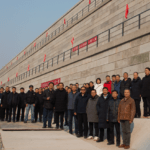 Application
Application
Zengwun reservoir had suffered from a large amount of sediment after every typhoon disaster, which seriously affects the reservoir operation. A new desilting tunnel is constructed to be the suitable dredging approach, and it brings about subsidiary revetment construction in response to spoil disposal. Also, the overflow prevention during discharge needs to be taken into consideration.
The Conventional Solution
The common countermeasures for riverbank protection are high durability, rigid concrete structures, but coupled with higher energy consumption as well as carbon emission, and its inability to dispose spoil results in additional cost in earthwork cleaning. Both explicit cost and implicit cost of the whole construction will increase. It stands to reason that an economical approach to reuse the spoil and construct revetments simultaneously is in demand.
ACE Solution
A composite system is applied to revetment construction, and it can be divided into two parts: concrete retaining wall under the water level to resist water flow impact and a geosynthetic reinforced structure above it, both including drainage systems. ACEGrid® geogrid is a product with a high modulus which is made of polyester with a durable polymer coating. By suitable installation and compaction, proper ACEGrid® can be interlocked with soil and compen-sate for the tensile strength of soil mass, constituting a reinforced structure with safety and stability. The total height of whole structure is 13m approximately, that consists of 8m-height concrete retaining wall and about 5m-height wrap-around reinforced structure. Spoil from the tunnel is the major fill in the reinforced zone, and few deposits in the river are also used to offset the lack. Around 60,000 sqm ACEGrid® are used for 780m-length revetment.
With the tunnel construction process, the revetment structure finished one after another, and 165,000m3 of spoil is reused, that both dispenses with earthwork cleaning and saves the cost of reinforced fill. The hydroseeding after construction takes on good vegetation effect 3 months later, and the water level would not exceed the top of concrete wall even while the sluice is open. These revetments not only solve the problems of spoil disposal and overflow, but also reduce the carbon emission in case the structures are originally all made of concrete. Also, the effects on land-scape and ecology are clearly displayed.
 Further information
Further information
For more information about ACE Geosynthetics, visit www.geoace.com or contact sales@geoace.com.






















